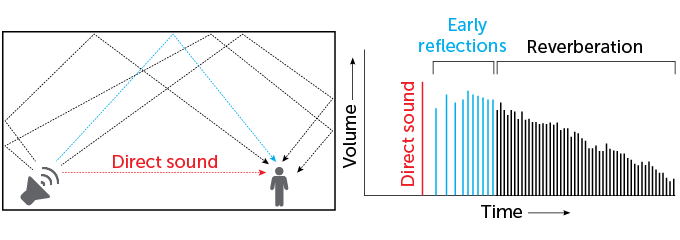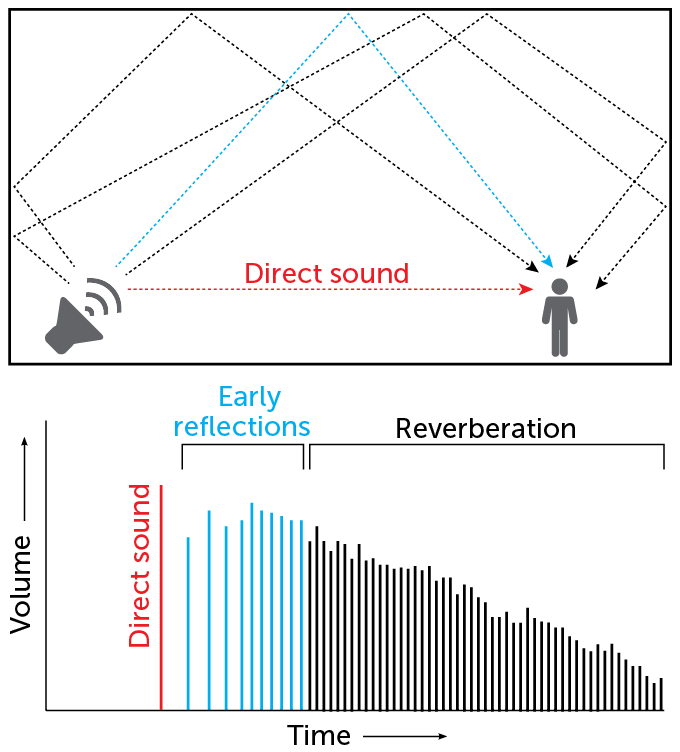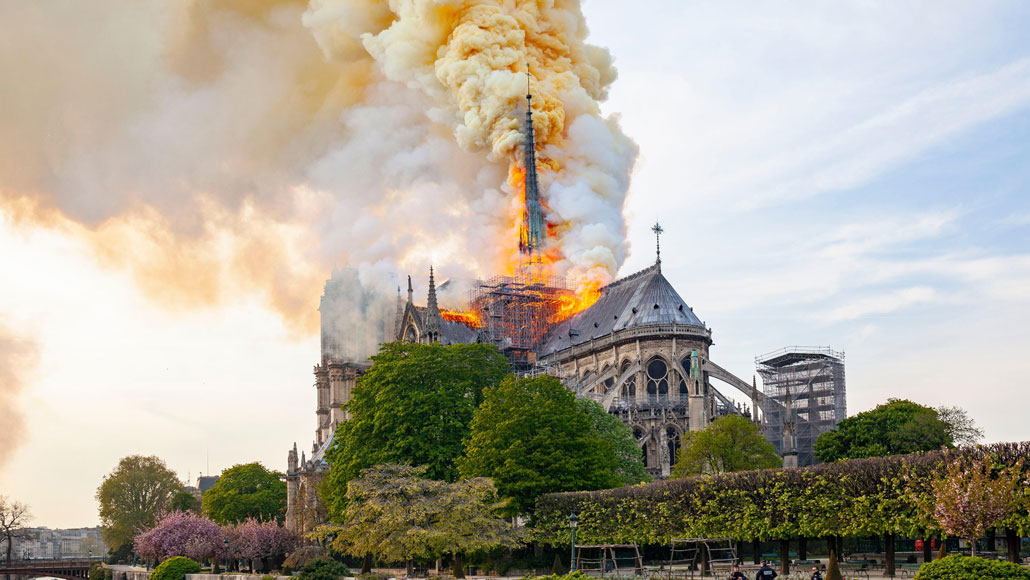
A fire damaged Paris’ Notre Dame cathedral in April 2019 (shown). Now, as the cathedral is rebuilt, researchers are using principles of physics to understand and protect the medieval church’s reverberant acoustics.
Hemis/Alamy Stock Photo
For centuries, the interior of Notre Dame never saw much sunlight. But when Brian Katz stepped inside the cathedral last July, the place was drenched in light, its famous arched ceiling open to the sky. Nearly three months before, on April 15, 2019, a fire had ripped through the Paris cathedral. Now, charred wood lay heaped on the floor, mingled with toxic lead dust. The acrid scent of fire lingered. But Katz and his colleague Mylène Pardoen had one main concern: the sound.
Something fundamental to Notre Dame’s voice was missing: its reverberance, that echolike quality that the grandest cathedrals are known for. “You didn’t hear the building anymore,” Katz says.
Before the fire, the tap of a heel or a cough would hang in the air for many seconds, a feature that imbued visitors with a tendency to step softly and keep voices low. Notre Dame de Paris — which translates as “Our Lady of Paris” — had a way of imposing silence upon her guests. To Katz and Pardoen, the cathedral’s personality had been erased.
But there was reason for hope. Much of the cathedral remained relatively untouched by the fire; wooden chairs still stood neatly in rows, and paintings and sculptures — though covered in dust — remained intact.
Preliminary repairs had already begun. Damaged pillars and flying buttresses were reinforced, and nets hung high in the arches to catch falling debris. Robotic devices swept up rubble in places too dangerous for humans to set foot.
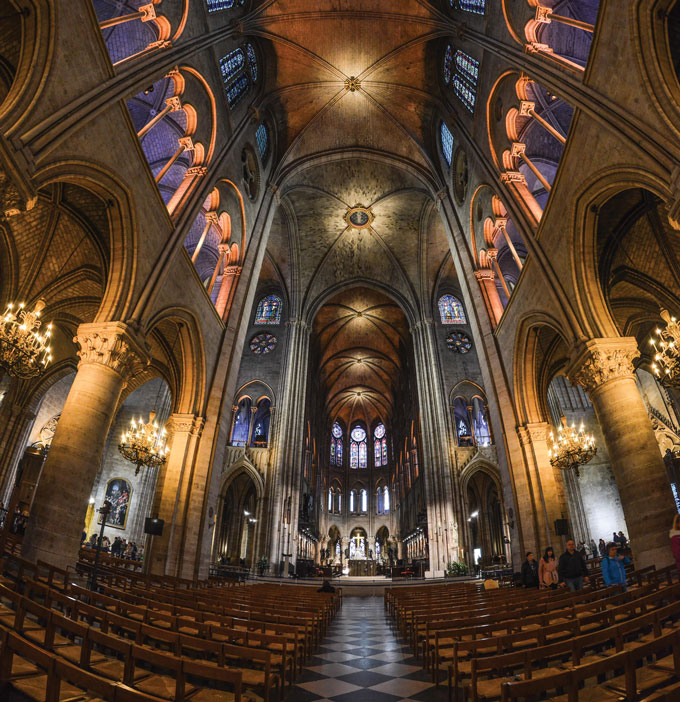
As architects, builders and historians begin the process of rebuilding Notre Dame, Katz — an acoustics researcher at CNRS, the Centre National de la Recherche Scientifique, and Sorbonne University in Paris — is on a mission to help restore the building’s sonic signature.
Similar work has been happening at other historical places, too. The disaster at Notre Dame has put a field known as heritage acoustics in the spotlight. Science has made it possible to document the acoustics and re-create the symphonic grandeur of destroyed or altered structures. Researchers are wielding their knowledge of physics to unveil a hidden history of sound in historical buildings.
“The past was not a silent place,” says acoustician Damian Murphy of the University of York in England. “Sound is a fundamental part of our human experience.”
At Notre Dame, Katz and colleagues had a fortuitous head start. Using a computer simulation and acoustic measurements the group made in the intact cathedral in 2013, the researchers had already digitally reproduced the building’s reverberance. Katz is using that work to predict how choices made during the reconstruction might alter Notre Dame’s effect on the ears.
He can also resurrect the acoustics of Notre Dame of old, showing the impact of renovations from previous eras in the medieval cathedral’s past, focusing on how the building would have responded to the sounds within. Meanwhile Pardoen, of CNRS and the Maisons des Sciences de l’Homme in Lyon, aims to re-create those long-ago sounds.
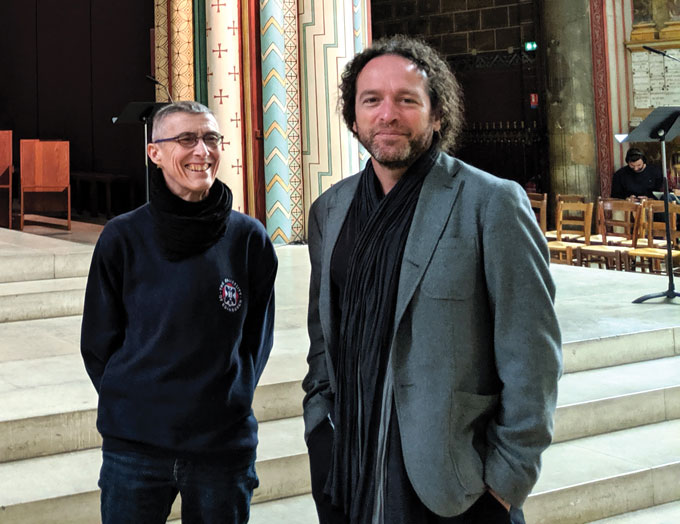
Sound is a transient, ethereal phenomenon, and it tends to be neglected in historical records. While photographs and drawings can preserve the visual impact of a building or scene, documenting the sonic impact of a space is more complicated. But for many people, sound provides an intimate part of the sensation, the je ne sais quoi of being in a particular place. Eyes closed, you can still tell immediately whether a room is tiny or soaring and grand.
Aural history
Cathedrals are a classic study subject for heritage acoustics. But sonic scrutiny has been applied to other spaces, including other religious buildings, theaters and even prehistoric caves (SN Online: 7/6/17; 6/26/17). Murphy, for instance, has studied the acoustics of a beloved chocolate factory and an underground nuclear reactor cavern.
For cathedrals in particular, “the sound and the feeling you get when you are inside … is key for the character” of the buildings, says acoustic engineer Lidia Álvarez-Morales of the University of York. She and colleagues recently measured the acoustics of four English cathedrals, including York Minster. That Gothic structure is larger than Notre Dame and suffered a catastrophic fire in 1984. The cathedral was later restored.
The acoustics within a room are all about how the sound reflects off the surfaces inside. When you clap your hands, for example, vibrations of air molecules travel in a wave, causing variations in pressure. Some of those waves travel directly to your ear, which registers an immediate sound. But others travel in all directions until they reach a surface such as a wall, floor or object within the room. Sound waves can bounce off that surface and reach your ear at a later time (SN: 7/13/13, p. 10).
In a place with a single reflecting surface, such as the distant wall of a canyon, the reflected waves produce an echo, a delayed repetition of the original sound. But in a cathedral, reverberation is the rule. “Reverberation happens when we have, say, a thousand reflections that are all coming back to us so fast that we can’t resolve any individual one of them with our auditory system,” says acoustician Braxton Boren of American University in Washington, D.C. As a result, the sound is drawn out, slowly trailing off to silence over several seconds.
Materials that tend to reflect sound waves and enhance reverberation, such as marble and limestone, are common in cathedrals. In contrast, a more typical room has surfaces — carpets, drapes and even the people within the room — that mostly absorb sound waves (SN: 11/15/03, p. 308). Larger rooms also boost sound’s staying power, as the waves take longer to travel between surfaces. Before the fire, with its arched limestone ceiling reaching 33 meters high and a 4,800-square-meter marble floor, Notre Dame was like a giant, mirrored fun house for sound, bouncing the waves around and around.
The reverberation time of a room is the number of seconds it takes for an initial, loud sound to become so quiet that it can no longer be heard. Specifically, it’s an estimate of how long it takes a sound to fade by 60 decibels. While a typical living room might have a reverberation time of half a second, and a concert hall might reverberate for two seconds, cathedrals can have reverberation times in excess of five seconds.
With long reverberation times, fast-moving music or speech can be muddied, with notes and words stepping on top of one another. Gothic cathedrals were designed to be grand spaces — their long reverberation may have been a by-product. But music evolved to fit the space: For organ music or religious chanting, “the acoustic conditions are really good, because this kind of music has been designed for those buildings,” Álvarez-Morales says.
In fact, Notre Dame’s special sound may have inspired the birth of polyphonic music — in which different voices sing separate notes, instead of the same pitch — in the 12th and 13th centuries. The Gregorian chants sung in the cathedral in medieval times were monophonic, featuring only one note at a time. But the drawn-out acoustics meant that consecutive notes tended to overlap.
Some acousticians believe this effect may have provided a chance to experiment with which notes sounded good together, eventually developing into voices singing in harmony. This practice is now so common it seems obvious. But at the time, it was revolutionary. As a result, the roots of modern Western music may have been shaped by the acoustics of Notre Dame. “It’s incredibly historically significant,” Boren says.
Sound of silence
On the day of the fire, Parisians gathered to watch the dramatic blaze. When Katz first heard the news, he didn’t quite believe it. Like so many others, he decided he had to see for himself.
Despite the throngs, Paris was mostly silent, Katz says. “No one was really talking above a whisper. To have that many people staring in awe was really strange.” Katz opens his eyes wide while remembering the scene. “No one knew what to say or what to do, but we were all standing there.”
The next day, Katz realized there was something he could do. The 2013 data his group had taken were the only detailed measurements of the acoustics of Notre Dame. He also had his computer simulation of the cathedral. Such acoustic models include the locations of the various surfaces within a room along with estimates of how well each material would absorb sound. And despite the destruction of the cathedral’s roof and medieval timbers, talk of restoring the wounded edifice had already started.
Inside the cathedral, Katz had measured a property known as “room impulse response,” which captures how the sound levels within a room vary over time after a brief initial noise. From that impulse response, researchers can derive the reverberation time and subtle characteristics that can affect how a listener perceives a room. One such property is the length of the delay between when the first sound waves reach a listener and the arrival of the second, reflected set of sound waves.
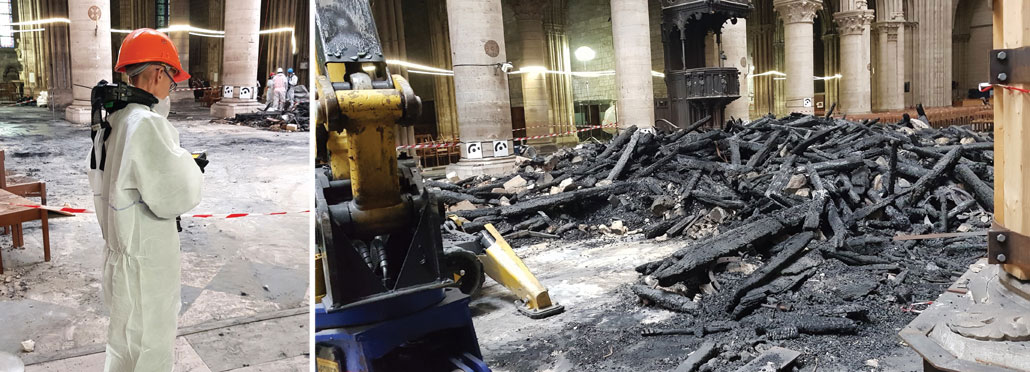
Using these measurements of the cathedral, Katz had calibrated his computer model, which allowed him to accurately reproduce Notre Dame’s lost acoustics. And now he could tell architects what they needed to do to ensure the building would maintain its acoustic splendor.
Katz exudes a nearly constant air of bemusement, as if he can’t fully grasp the cosmic circumstances that led him to become the foremost expert on Notre Dame’s acoustics. With a graying beard and long wavy hair tied back in a loose knot, his look is halfway between musician and physicist. But neither category quite fits: He doesn’t play any instruments, and he’s not a conventional physicist.
As a child, Katz’s attempts at learning musical instruments fizzled: He abandoned both the cello and the saxophone. While studying physics at Brandeis University in Waltham, Mass., Katz diverged from his college classmates, who were fascinated with astrophysics or subatomic particles. “That wasn’t really my thing,” Katz says: He stuck to the human scale.
Eventually, Katz stumbled into acoustics thanks to his experience setting up sound systems for events at Brandeis. With a Ph.D. from Penn State, he eventually became an acoustics researcher in Paris. But he’s no audio-gear geek either. He declares that his home audio system is “crap.”
Music from ruins
The acoustic properties of damaged or demolished buildings have been resurrected before. Murphy and colleagues re-created the 16th century sound of a ruined church called St. Mary’s Abbey, founded in 1088 in York. Today, only remnants of the abbey’s walls endure — arched windows frame sky and trees within a city park. But Murphy and colleagues pieced together the architecture of the lost church as best they could, consulting with archaeologists and studying historical references. By putting that information into a computer simulation, the group got a sense of how the space would reverberate.
In 2015, singers performed a concert within the ruins, with the original reverberation of the abbey applied to their voices in real time. Audience members seated within the church’s footprint heard what the music would have sounded like in the intact space.
Like an acoustic time machine, such techniques can also help researchers understand how the acoustics of still-intact buildings might have differed in the past, as a result of either renovations or differences in how the church was used or decorated, and how that would have altered the music played within them. “For anyone who’s fallen in love with music from another era, we can’t really re-create it without re-creating the acoustic conditions,” Boren says.
For example, in the 16th century Church of the Redentore in Venice, Italy, music was composed for a special festival held each July, when citizens packed the church. All those people could have had a big impact on the sound: Humans “are actually one of the most absorbent surfaces,” Boren says.
The festival still takes place today, but the church uses speakers to amplify the music, which drastically changes the acoustics, Boren says. He wanted to understand how the church sounded during festivals of the past.
Boren and colleagues produced an auralization of the church, the acoustic equivalent of a visualization. The researchers took a musical recording from a space with very little reverberation and applied the acoustics from their simulation of the church — both with and without the crowd.
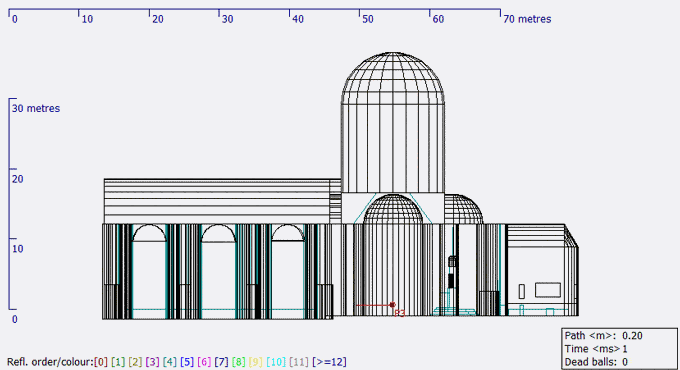
That involved a process called convolution, which changes how long various frequencies hang in the air. The musical recording was broken up into tiny slices in time, and each slice was multiplied by the room’s impulse response. Summing up all those slices produced the final sound.
Prior measurements had revealed that the empty church had a reverberation time of seven seconds. But in Boren and colleagues’ simulation, reverberation time was cut in half when the church was filled with people and decked out with festive tapestries.
When the church was full, sounds didn’t ring out as long, so the notes came through more clearly. In the past, when composers wrote music for the Venice landmark, they may have taken the room’s reverberation time into account, including the effects of the crowd.
The work was made easier by the fact that the building the team was studying is intact, and the researchers had measurements from within. Whereas Murphy’s team had to use a fair bit of guesswork to simulate the ruined St. Mary’s Abbey, Boren’s group used its data to ensure the simulation faithfully re-created the building’s sound. The same goes for Katz’s Notre Dame simulation, which is why his prefire measurements are so crucial.
“It’s incredibly lucky that Brian [Katz] was able to get into that space and take all the measurements that he did,” Boren says. “Those are going to be very critical for actually isolating what the acoustics of Notre Dame were like before.”
The measure of a cathedral
On April 24, 2013, six years before the fire and 850 years after Notre Dame’s first stone was laid, Katz and colleagues arrived at the cathedral lugging microphones and other equipment. Late that night, after a concert had ended and the last of the musicians and concertgoers had spilled out into the spring evening, Katz and his team got to work.
Microphones stood like silent sentinels in the centuries-old aisles. Orange and black cables threaded through walkways. A laptop rested on a chair — a seat normally occupied by the faithful now reserved for technology. And a dummy of a human head outfitted with microphones in its ears perched on a post, its blank face surveying the ornate surroundings.
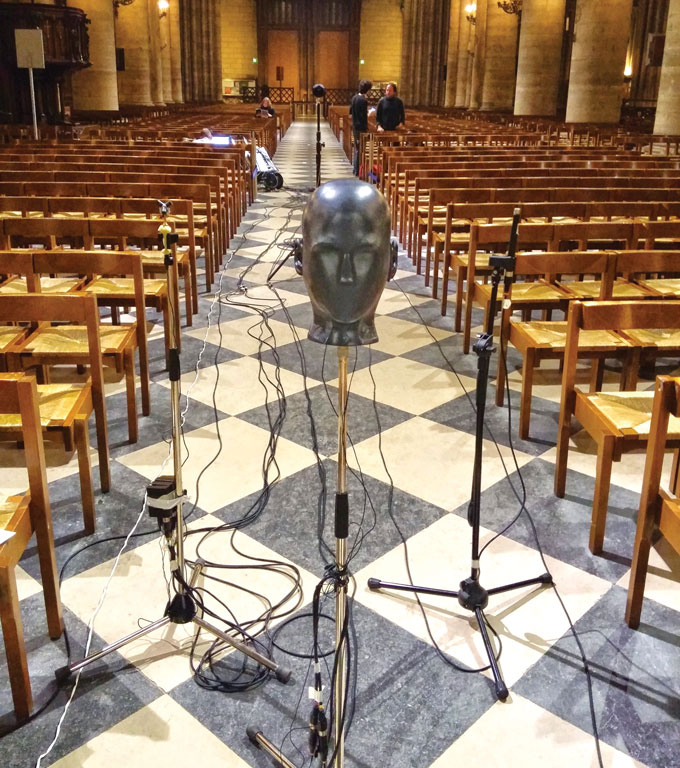
To precisely pin down Notre Dame’s room impulse response, Katz’s group played a sound called a sine sweep, which starts on a low note and slides gradually up to a higher pitch. It’s designed to test the full range of pitches that humans can hear, because different pitches can reverberate for different lengths of time.
Microphones measured the cathedral’s response to the sine sweep. That response varies based on where in a room the sound is coming from, and where the microphone is. So the researchers moved the speaker and microphones from place to place, repeating the measurements. Using that data, Katz calculated that Notre Dame’s reverberation time was around six seconds on average — more than 10 times as long as a typical living room’s. The reverberation time varied depending on the pitch; for a note of middle C, the reverberation lasted eight seconds.
Tuning up
Next, Katz and colleagues turned to the computer simulation, comparing the simulated reverberation with the reverberation they measured in the cathedral. The results were close, but didn’t quite match for all frequencies of sound. That’s to be expected: Notre Dame’s walls might be a little better or worse at absorbing sound than a typical limestone wall, for example. So Katz and colleagues tweaked the amount of absorption of various surfaces until the acoustic properties of the simulated cathedral aligned with reality.
The researchers then made an auralization of Notre Dame, using audio from the concert that took place in Notre Dame the night that Katz made his measurements. That concert, a performance of “La Vierge,” composed by Jules Massenet in the late 19th century, was recorded with microphones positioned very close to the performers. The mics picked up mostly direct sound rather than the cathedral’s reverberation. Katz used his computer model to re-create how the concert would have sounded for a listener wandering through other parts of the church.
Next, Katz and colleagues added visuals to that audio to make a virtual reality re-creation of the performance, which they call “Ghost Orchestra.” They reported the work at the European Acoustics Association’s EuroRegio conference in 2016. Wearing a virtual-reality headset, the viewer flies about the simulated cathedral as the music plays, swooping low over the orchestra. In the far reaches of the building, the individual notes are more muddied. Turn your head, and as your ears move positions, the sound changes too. Since the fire, Katz and colleagues have been working on improvements to the video.
Brian Katz and David Poirier-Quinot/CNRS, Sorbonne University
Moving forward, Katz plans to tweak his model to account for the design and materials to be used in the proposed cathedral refurbishments. Even relatively minor choices — such as whether to carpet some of the aisles — could create a noticeable difference. Katz also aims to adjust his model to understand how Notre Dame may have sounded in the past, cataloging its progression through a series of changes. Some of the past renovations could have altered the cathedral’s acoustics, even cosmetic changes like coatings of paint and the hanging of tapestries or artwork.
No building stands for 850-plus years without damage, refurbishments and aesthetic tweaks. Once Notre Dame’s construction began in 1163, it continued off and on for almost 200 years, until the middle of the 14th century. In 1699, King Louis XIV started a round of updates, including a new marble altar, with statues of himself and his father flanking the Virgin Mary holding Jesus’ dead body.
During the French Revolution, statues were beheaded, and the church was used as a warehouse, falling into disrepair. Victor Hugo’s novel The Hunchback of Notre Dame was published in 1831 and may have inspired Parisians to give the cathedral some TLC. Beginning in 1845, renovations led by architect Eugène-Emmanuel Viollet-le-Duc shored up the crumbling structure and added the cathedral’s spire (destroyed by the 2019 fire), among other changes. The fire is believed to have broken out accidentally during restoration work.
Crafting a soundscape
One thing Katz can’t do is reproduce the actual sounds that might have been present in those earlier eras. That’s the specialty of Pardoen, Katz’s companion on the July visit to the damaged Notre Dame. Calling herself a “soundscape archaeologist,” Pardoen pieces together the sounds of past environments: battlefields, cathedrals and cities.
With close-cropped gray hair and dark clothes, Pardoen seems no-nonsense. But chatting with Katz over coffee, she breaks the veneer of seriousness by frequently interrupting the conversation to mimic the noises she studies, like the “choo click choo click” of a loom or the “crrrrrr” of stone cutters.
Her magnum opus is a video soundscape of central Paris during the second half of the 18th century, when Paris streets bustled with people, and bridges were crammed with buildings several stories high. In the video, the viewer wanders the city streets, taking in the sounds: the clacking of horse hooves, washerwomen working at the banks of the Seine, leatherworkers engaged in their craft and even the buzzing of flies around the fish market.
Projet Bretez/CNRS
To cultivate this sonic bouquet, Pardoen consulted maps, historical documents and paintings. She found replicas of the tools that would have been common at the time and recorded them in use to collect historically accurate sounds.
Now, Pardoen plans to exhume the forgotten sounds of Notre Dame. Rather than re-creating religious ceremonies or concerts, she’ll focus on the everyday noises. In earlier times, artisans and merchants crowded the neighborhood around the cathedral, and the resulting cacophony leaked into the church’s interior. By filtering these sounds through Katz’s acoustic model, Pardoen and Katz aim to achieve the ambience of Notre Dame at various periods of its history.
As the cleanup progresses, Katz and Pardoen will return regularly to monitor the acoustics of the damaged building. The two are part of a group — Association des Scientifiques au Service de la Restauration de Notre-Dame de Paris, the Association of Scientists in the Service of the Restoration of Notre Dame of Paris — that aims to consolidate scientific expertise to better understand the cathedral and assist in its reconstruction.
Parisians will have to decide which version of the cathedral to aim for, the Notre Dame that existed just before the fire, a version from an earlier era or something new and different. Giving architects, politicians and the public a chance to explore the sonic history of Notre Dame could help inform decisions about its future.
“No historic building is ever completely static,” says Murphy, of the University of York. “This terrible fire, which is a considerable tragedy, is just the next stage in the life of Notre Dame.”
